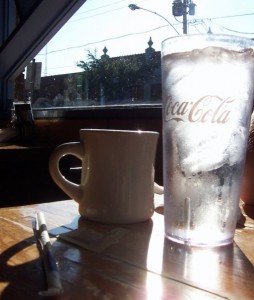We’re into the depths of New Year’s resolution season and one of the most typical resolutions of the season is losing weight. And since our economy is in the crapper (oh you didn’t know?) I figured I could pair our continuing series, Thrifty District with everyone’s favorite New Year’s resolution and give you some tips on how to lose weight in 2009, while still maintaining a budget. I’ve got some cheaper alternatives to the gym (and great places to get gym time for free!), cheap yet healthy foods to eat recommended by nutritionist Danielle Omar, and some great places to find healthy recipes online (you know, so you don’t have to spend money on cookbooks!).
So, one of the most expensive things about losing weight is investing money into a gym membership. Luckily, there are some GREAT, and free, trails in DC. So all you’ll be paying is for a bike (you can find some great deals on craigslist), or some running shoes. Here’s a sample of some of my favorite trails in our area. Click on the links below to be taken to the trail descriptions on TrailLink.com; where you can find trail Google maps, user reviews and photos.
1. The Capital Crescent Trail which runs from Bethesda to Georgetown
2. The Mount Vernon Trail which runs from Arlington way out to Mount Vernon and is my personal favorite
3. The W&OD trail which runs from waaay out in NOVA (Purcellville) into Arlington and beyond
4. Rock Creek Park trails
So, work off those calories on local trails! You can burn anywhere from 300 calories to 800 calories an hour riding your bike, and from somewhere around 500 to 900 calories an hour running.
If you have Comcast (may the force be with you, my friend) you might have On Demand, which gives you access to a whole new realm of free fitness. You can tune in to On Demand and have access to tons of cardio, weights, or yoga workouts. If you don’t have Comcast (lucky) or don’t have On Demand, FitTV has tons of videos accessible online available for you to watch for free. There are also tons of other web sites available to help motivate you. The Plus 3 Network allows you to log on and track your work outs, and then will make charitable donation for each mile you walk, jog, bike or swim. You can choose your cause, and then give, just by tracking your progress. It’s a win-win situation!
But, of course, some situations DO call for a gym. I personally love going to the gym, especially since I got a great deal on my membership. Don’t forget, gyms are in dire straights too, and offering good deals around the New Year! Bargain hunt, and don’t believe the first price quoted to you, there are loopholes, and the gym is probably desperate to sign you. Right now WSC has no joining fees, and Gold’s Gym is offering 3 personal training sessions for $99, just to name a few.
But these days, people are getting really creative about working out on the cheap. Vicky Hallett from the Washington Post wrote an article that WLDC author David sent me – Can We Really Find You A Free Workout in Washington? Yes We Can. Hallett’s article is packed full with tips and places in the DC area where you can get a free work out. She’s compiled locations for free yoga classes, great running groups, and how to get a free CrossFit class every Saturday morning. There are even tips on free Tai Chi and Abs classes in the metro area. So click on through, she basically wrote the gym part for me!
The second half of losing weight is thinking about what you eat. Fabulous Vienna-based nutritionist Danielle Omar was gracious enough to give me a list of four cheap but essential diet foods. (Danielle also writes a super helpful blog, which offers handy advice for free! See, I told you she was great.) Danielle suggests eating:
Eggs: 1 dozen large eggs averages $1.99 which is about $0.16/egg. Eggs are a great source of protein and contain antioxidants lutein and zeaxanthin which have been shown to help prevent macular degeneration. They are also a good source of choline. Choline is a nutrient that helps regulate the brain and nervous system.
Bananas: Bargained priced at about $0.25 each. Great source of potassium which helps to lower blood pressure. Also high in fiber and just the right amount of sugar to satisfy your sweet tooth. Great in smoothies and perfect for a pre- or post-workout snack.
Beans: One can of beans – about $0.75. Beans are a versatile nutritional powerhouse! Not only are they low in fat and a great source of the soluble fiber that helps lower cholesterol, they’re also high in protein, iron, folate and potassium. Studies show that eating beans on a regular basis reduces the risk of developing diabetes, heart disease, cancer, and obesity.
Sweet Potato: 2 lb bag for $2.50. Sweet potatoes are an antioxidant-rich, anti-inflammatory food. They are low in fat and calories and high in Vitamin A, Vitamin C, manganese, copper, fiber, vitamin B6, potassium and iron!
I also asked Danielle to make a list of cheaper places to shop, and she gave me this list:
Trader Joes (less expensive than Giant/Safeway – especially organic foods and fresh/frozen meats, etc.)
Super H Mart (Korean grocery store chain great produce and fresh fish/meats; also has weekly coupons online like strawberries for $1.79/pack and grapes .99/pound, etc.) http://www.hmart.com/
Wegmans is definitely the cheapest grocery store compared to other national chains.
And don’t forget that stores like Giant will email you their sales weekly, just log onto the site and sign up to receive your e-flier. Danielle suggests that you “stay away from prepared foods or pre-cut, pre-chopped produce! Buy carrots and other veggies whole and slice at home. Especially stay away from bagged lettuce and other greens and veggies.” She said if you’re trying to pinch pennies, purchasing the 100 calorie packs, fruit cups and individually portioned yogurts are more expensive than if you were to buy the larger size and ration the portions for yourself. “However,” Danielle says, “Bigger is not always cheaper, so make sure to check the unit price. The “unit price” tells you the cost per pound, quart, or other unit of weight or volume of a food. It is posted on the shelf below the food. You can save money when you compare the cost of the same food in different sized containers or different brands. For example, if you want to buy frozen orange juice you may find a 6-ounce can that cost $.64. The unit price for this small can is $3.42 per quart. A 12-ounce can of frozen orange juice in another brand may cost $.89. The unit price for the larger container of juice is listed as $2.38 per quart. Here, the larger container is cheaper per quart.”
So now you know how to shop cheaper, but where do you find all the recipes? There are some really great online sites for healthy eating and diet-friendly recipies. My favorite of all is Kayln’s Kitchen, a South Beach Diet blog that’s accessable to everyone (even those of us not on the diet). I’ve never tried anything from that blog that I didn’t like, plus she sorts everything by food type, in case you’ve got an ingredient you’re looking to use. The Food Network web site has a feature of 30 days of healthy eating happening right now, and tons of diet tips along with the recipies. FitSugar is a source of daily inspiration for me, and Fit always has tons of snack ideas and healthy dinner ideas on the site, in addition to work out tips.
So, don’t let money issues stand in your way! There are plenty of places to go to get a free work out! The hardest part is motivating to lace up your shoes, the rest has a way of taking care of itself.
Thanks again to nutritionist Danielle Omar for all her help with this post, as well as flickr user NCinDC for the trail photo! Other photos courtesy of flickr user Needlessspaces.



Lutein and Zeaxanthin are two carotenoids found in both the retina and lens of the eyes that act as both powerful antioxidants, as well as like a having pair of “internal sunglasses” as they help filter UVA/UVB and blue light.
One or both of these nutrients can be found in such foods as green, leafy vegetables, orange and yellow peppers, broccoli, brussel sprouts, corn and eggs.
A number of peer review research studies have shown that supplementing with lutein and zeaxanthin can significantly reduce the changes of getting macular degeneration. Taking fish oil (omega-3 fatty acids) daily is also proving invaluable in helping prevent the onset of Macular Degeneration. These nutrients are also essential to take for those with macular degeneration in helping preserve vision as has been shown on the recent AREDS2 study.
For more related research studies, see the “Research” section at Natural Eye Care for Macular Degeneration